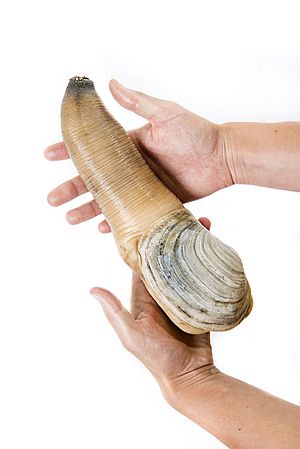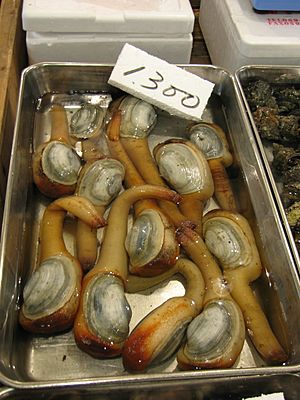Geoduck facts for kids
Quick facts for kids Geoduck |
|
|---|---|
 |
|
| A live specimen of Panopea generosa | |
| Scientific classification |
The Pacific geoduck (pronounced “gooey-duck”; Panopea generosa) is a very large saltwater clam. It belongs to the family Hiatellidae. Its unique name comes from the Lushootseed (Nisqually) word gʷídəq.
Geoducks live in the ocean waters off western Canada and the northwest United States. Their shell is usually about 15 to 20 centimeters (6 to 8 inches) long. But the clam itself is much longer! This is because of its super long "neck," also called a siphon. This siphon can stretch up to 1 meter (3 feet) long.
The geoduck is the biggest burrowing clam in the world. It also lives for a very long time. Most geoducks live for about 140 years. The oldest one ever found was 168 years old!
Contents
What's in a Name?
The name geoduck comes from a Lushootseed (Nisqually) word, gʷídəq. This word might mean "dig deep." Sometimes, people call geoducks "mud ducks" or "king clams." In Chinese, its name means "elephant-trunk clam" because of its long siphon. When you see many geoducks together, it's called a "bag" of geoducks.
For a while, scientists mixed up the geoduck's scientific name. Between 1983 and 2010, it was sometimes confused with an extinct clam called Panopea abrupta.
Geoduck Life and Habits
Geoducks live along the west coast of Canada and the northwest coast of the United States. You can find them mainly in Washington and British Columbia. These marine bivalve mollusks are the largest burrowing clams on Earth.
An adult geoduck usually weighs about 0.7 kilograms (1.5 pounds). But some have been found weighing over 6.8 kilograms (15 pounds)! Some can even be 2 meters (6.5 feet) long from end to end.
A similar type of geoduck, Panopea zelandica, lives in New Zealand. People have been harvesting them there since 1989. There are some worries about more parasites showing up in geoducks in the Puget Sound area. Scientists are studying if commercial farming might be causing this.
How Geoducks Eat and Live
Geoducks use their long siphon to suck in water from the ocean. This water contains tiny food particles called plankton. The clam filters out the plankton for food. Then, it sends out the waste water through another part of its siphon.
Adult geoducks don't have many natural predators. This might be why they live for so long. In Alaska, sea otters and dogfish can sometimes dig up geoducks. Starfish also attack and eat the exposed siphon.
Geoduck Reproduction
Female geoducks release their eggs into the water. This is called "broadcast spawning." A female geoduck can produce about 5 billion eggs during her long life. However, not many of these eggs survive to become adult clams. Many eggs, larvae, and young geoducks die. Because of this, geoduck populations grow back slowly after being harvested. In the Puget Sound, it can take about 39 years for a harvested area to recover.
The Geoduck Industry
The first geoduck fishing started in 1970. At first, not many people wanted to buy them because of their chewy texture. But by As of 2011[update], these clams were selling for over US$33 per kilogram (US$15 per pound) in China!
Geoducks are now very valuable. This has created an $80-million industry. People harvest them in Alaska, Washington, Oregon, and British Columbia. This fishery is very carefully watched and regulated in both countries. In Washington, the Washington Department of Natural Resources checks harvests to make sure everything is done correctly. The Washington State Department of Health also tests the water and the clams to ensure they are safe to eat.
In 2007, new testing methods made it easier to deliver live geoducks to the market. Before, only 10 percent of harvested clams were alive when they reached the market in 2001. With the new tests, 90 percent were live in 2007. Live geoducks are worth much more money. This helped the industry grow a lot.
The COVID-19 pandemic caused problems for the geoduck industry. Many restaurants and seafood markets closed. This meant fewer people wanted to buy live geoducks. Divers in Southern Alaska saw prices drop from $11-$22 per kilogram ($5-$10 per pound) to as low as $2.20 per kilogram ($1 per pound). Many divers stopped fishing for a while.
Environmental Impact of Geoduck Farming
Some people have concerns about how geoduck farming affects the environment. However, groups like the Environmental Defense Fund say that bivalves like oysters, mussels, and clams are actually good for the ocean. To farm geoducks, the water must be very clean. Rules were put in place in 2007 to make sure this happens. Studies are being done to see the long-term effects of geoduck farming on the environment and other animals. So far, studies suggest that geoduck farming does not have long-term negative effects on threatened or endangered species.
How People Eat Geoducks
The geoduck's large, meaty siphon is popular for its good flavor and crunchy texture. It is a special food in China. There, it is often cooked in a hot pot, similar to fondue. In Korean cuisine, people eat geoducks raw with spicy chili sauce. They also stir-fry them or add them to soups and stews.
In Japan, geoduck is prepared as raw sashimi. It is dipped in soy sauce and wasabi. Sometimes, in cheaper sushi restaurants, another type of clam called a horse clam is used instead of geoduck. It is called mirugai or mirukuigai on the menu. People say it has a texture similar to an ark shell.
Chinese Import Ban
In December 2013, China stopped importing geoducks and other "double-shell aquatic animals" from the west coast of the United States. Chinese officials found high levels of a natural toxin called saxitoxin in a shipment from Alaska. This toxin can make people very sick or even cause death if eaten. Companies that export geoducks said that China was using stricter safety rules than needed. Another shipment from Washington state had high levels of arsenic. The ban lasted for less than six months and ended in May 2014.
Geoducks in Popular Culture
The Evergreen State College in Olympia, Washington has a geoduck named "Speedy" as its mascot!
See also
 In Spanish: Geoduck del Pacífico para niños
In Spanish: Geoduck del Pacífico para niños




